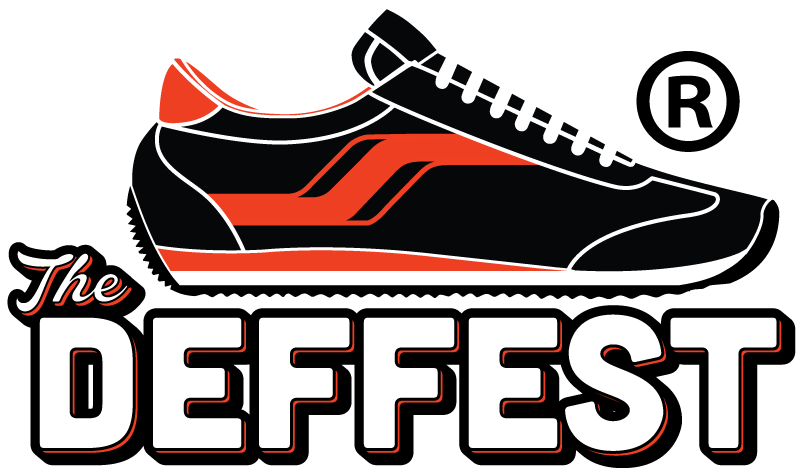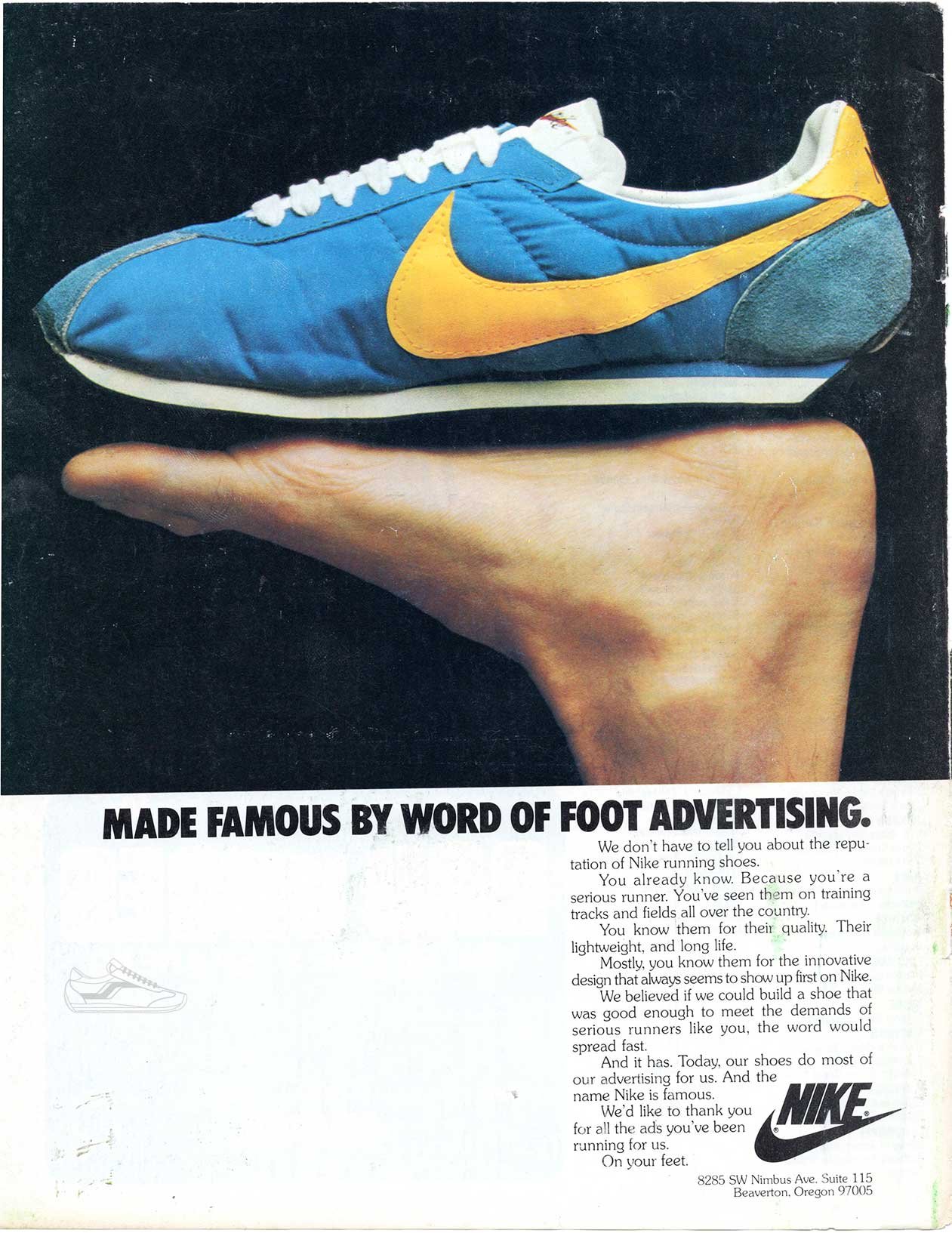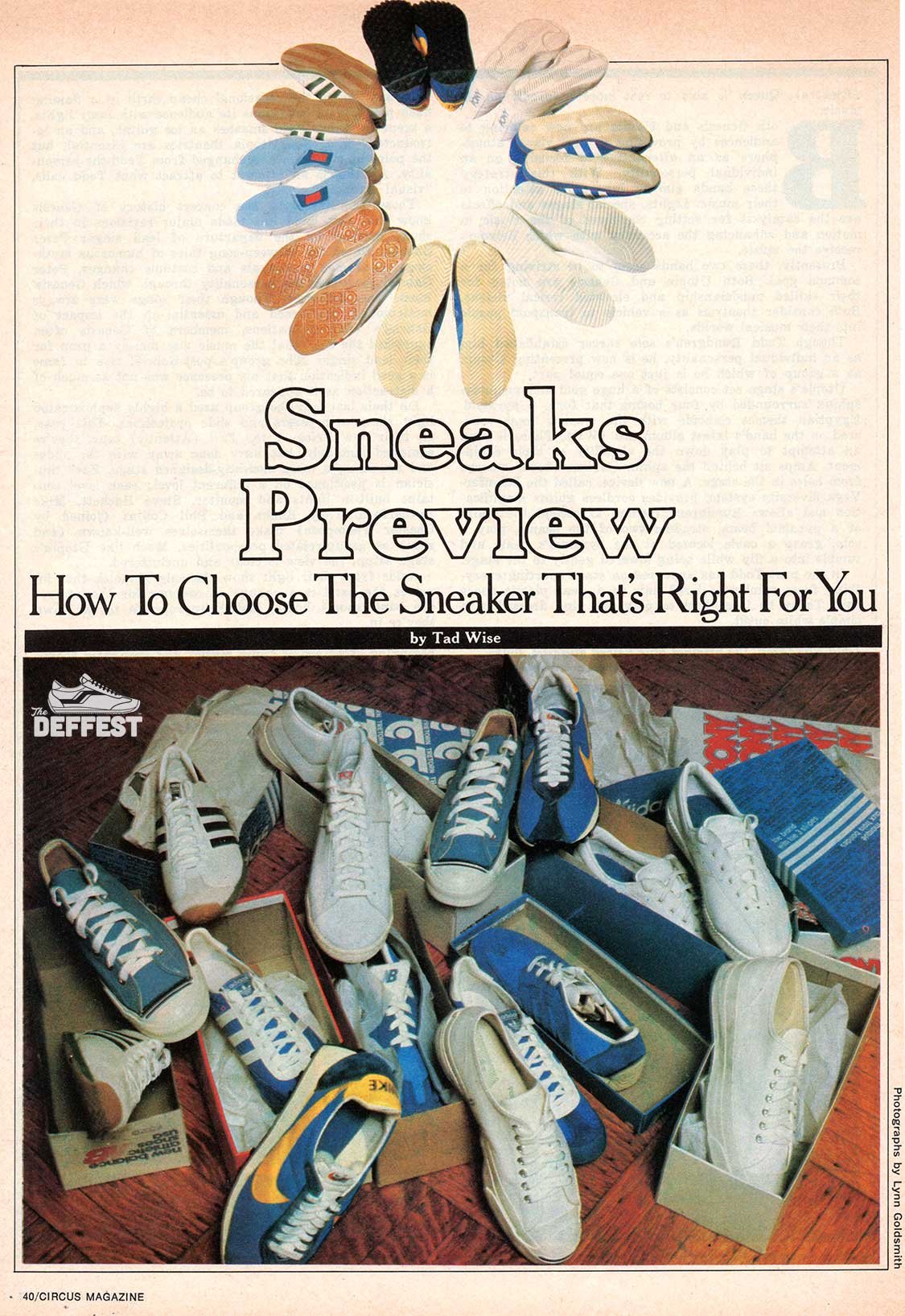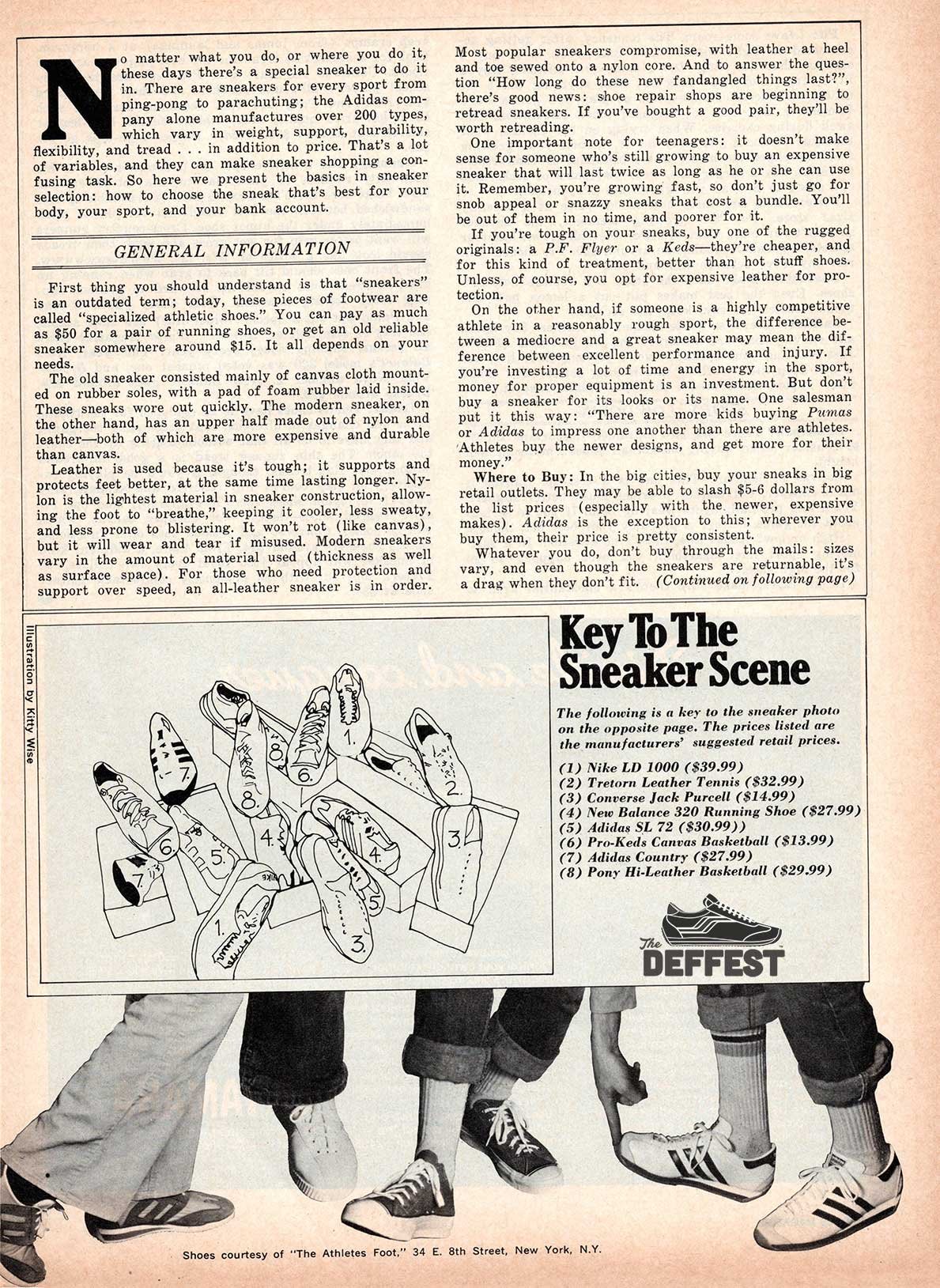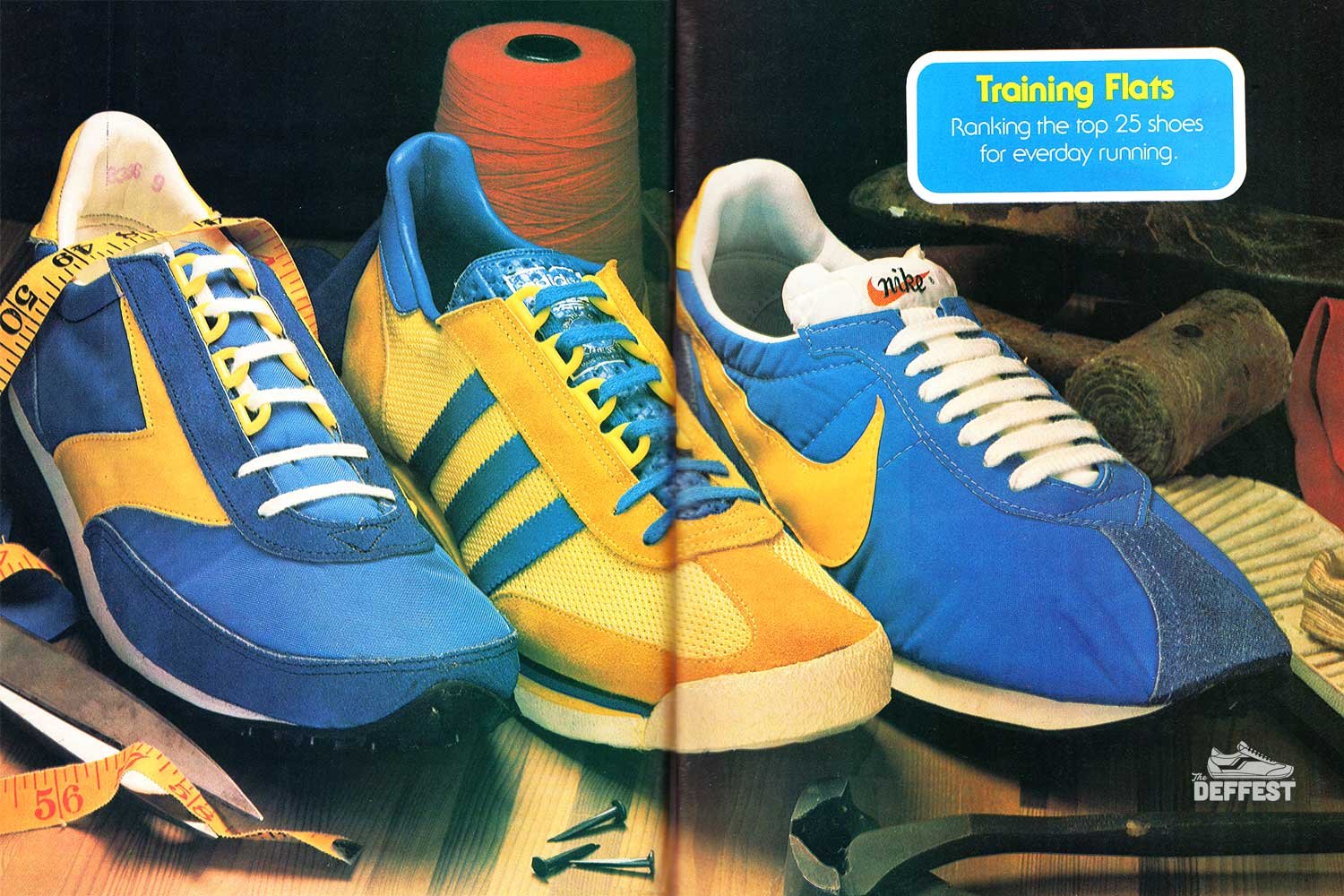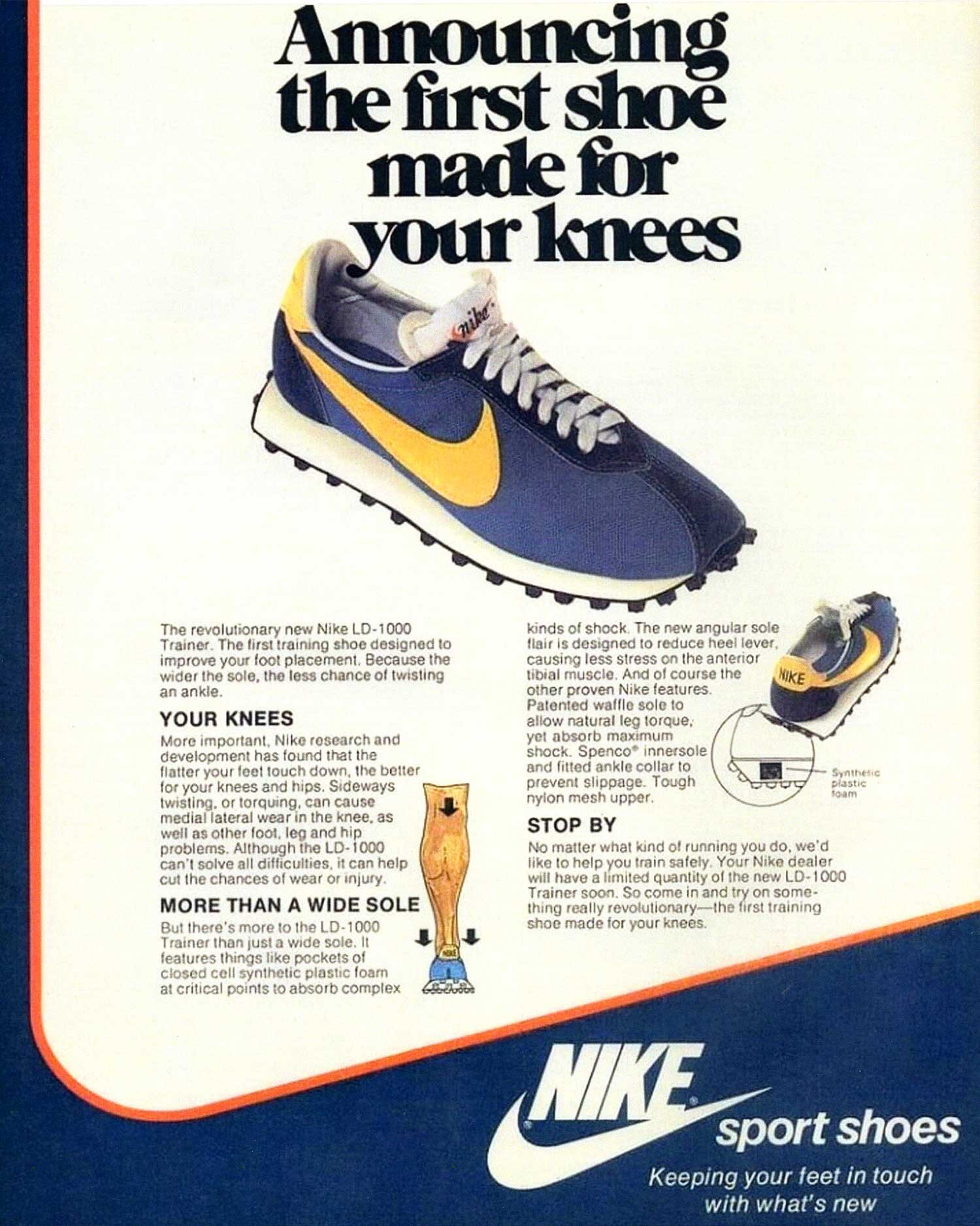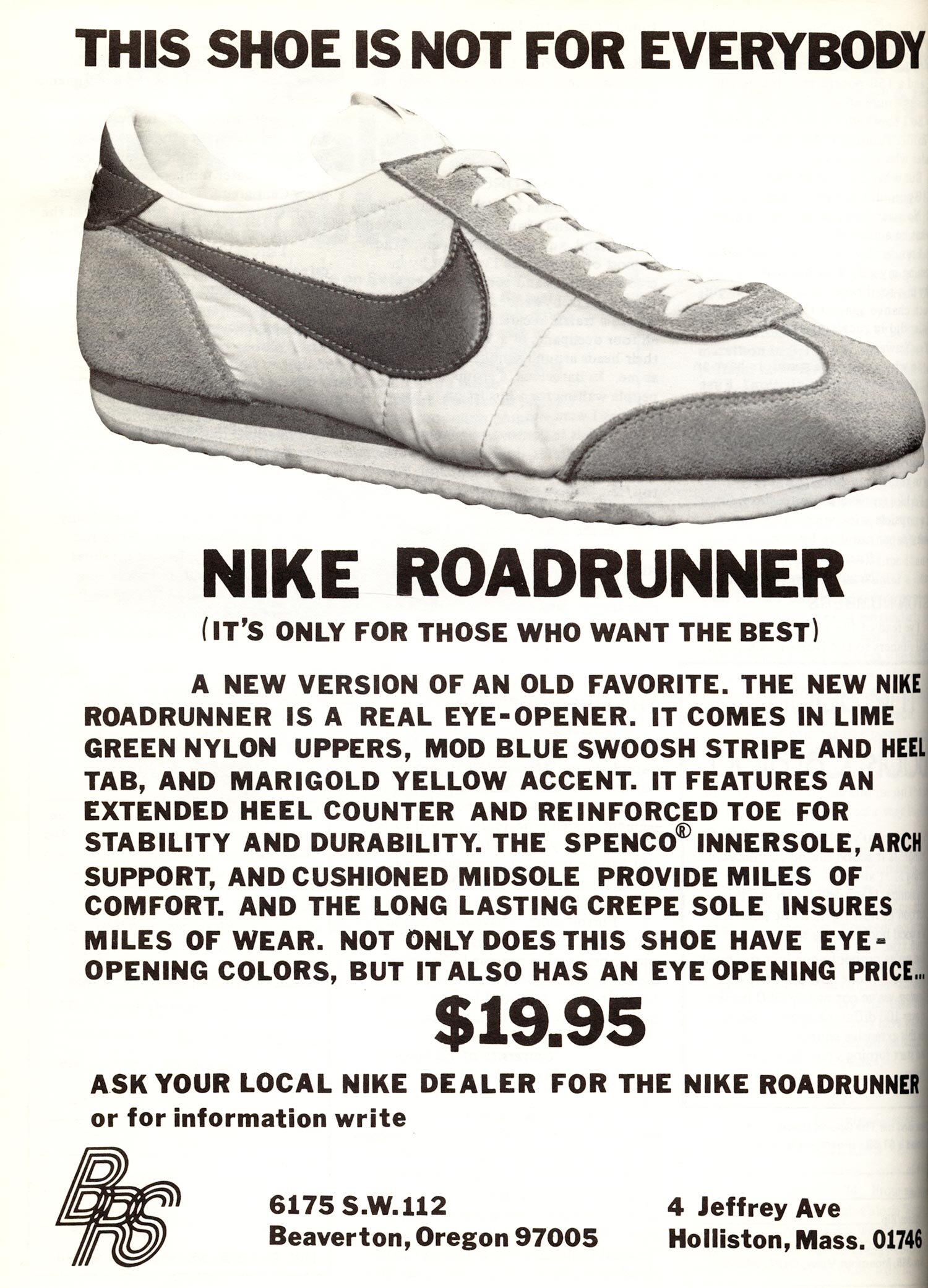Here’s an old school ‘Sneakers Preview’ feature from the rock n’roll magazine Circus. The article features vintage 1970s sneakers and running shoes form Nike, adidas, New Balance, Keds and PONY.
Article info is below:
SNEAKS PREVIEW
How To Choose The Sneaker That’s Right For You
By Tad Wise
No matter what you do, or where you do it, these days there's a special sneaker to do it in. There are sneakers for every sport from ping-pong to parachuting; the Adidas com-pany alone manufactures over 200 types, which vary in weight, support, durability, flexibility, and tread . . . in addition to price. That's a lot of variables, and they can make sneaker shopping a con-fusing task. So here we present the basics in sneaker selection: how to choose the sneak that's best for your body, your sport, and your bank account.
GENERAL INFORMATION
First thing you should understand is that "sneakers" is an outdated term; today, these pieces of footwear are called "specialized athletic shoes." You can pay as much as $50 for a pair of running shoes, or get an old reliable sneaker somewhere around $15. It all depends on your needs. The old sneaker consisted mainly of canvas cloth mount-ed on rubber soles, with a pad of foam rubber laid inside. These sneaks wore out quickly. The modern sneaker, on the other hand, has an upper half made out of nylon and leather—both of which are more expensive and durable than canvas. Leather is used because it's tough; it supports and protects feet better, at the same time lasting longer. Nylon is the lightest material in sneaker construction, allow-ing the foot to "breathe," keeping it cooler, less sweaty, and less prone to blistering. It won't rot (like canvas), but it will wear and tear if misused. Modern sneakers vary in the amount of material used (thickness as well as surface space). For those who need protection and support over speed, an all-leather sneaker is in order. Most popular sneakers compromise, with leather at heel and toe sewed onto a nylon core. And to answer the ques-tion "How long do these new fandangled things last?", there's good news: shoe repair shops are beginning to retread sneakers. If you've bought a good pair, they'll be worth retreading. One important note for teenagers: it doesn't make sense for someone who's still growing to buy an expensive sneaker that will last twice as long as he or she can use it. Remember, you're growing fast, so don't just go for snob appeal or snazzy sneaks that cost a bundle. You'll be out of them in no time, and poorer for it. If you're tough on your sneaks, buy one of the rugged originals: a P.F. Flyer or a Keds—they're cheaper, and for this kind of treatment, better than hot stuff shoes. Unless, of course, you opt for expensive leather for pro-tection. On the other hand, if someone is a highly competitive athlete in a reasonably rough sport, the difference be-tween a mediocre and a great sneaker may mean the dif-ference between excellent performance and injury. If you're investing a lot of time and energy in the sport, money for proper equipment is an investment. But don't buy a sneaker for its looks or its name. One salesman put it this way: "There are more kids buying Pumas or Adidas to impress one another than there are athletes. 'Athletes buy the newer designs, and get more for their money." Where to Buy: In the big cities, buy your sneaks in big retail outlets. They may be able to slash $5-6 dollars from the list prices (especially with the newer, expensive makes). Adidas is the exception to this; wherever you buy them, their price is pretty consistent. Whatever you do, don't buy through the mails: sizes vary, and even though the sneakers are returnable, it's a drag when they don't fit. (Continued on following page)
Key To The Sneaker Scene
The following is a key a the sneaker photo on the opposite page. The prices listed are the manufacturers' suggested retail prices.
Nike LD 1000 ($39.99)
Tretorn Leather Tennis ($32.99)
Converse Jack Purcell ($14.99)
New Balance 320 Running Shoe ($27.99)
Adidas SL 72 ($30.99)
Pro-Keds Canvas Basketball ($13.99)
Adidas Country ($27.99)
Pony Hi-Leather Basketball ($29.99)
Illustration by Kitty Wise
Shoes courtesy of “The Athletes Foot,” 34 E. 8th Street, New York, N.Y.
Fit: Leave some room. The tendency, after getting accustomed to tight winter shoes and boots, is to buy a sneaker that Its snug. Don't make this mistake. Buy a little large, and don't walk out with anything that's the tiniest hit uncomfortable—once at play, it's gonna hurt. Remember that due to increased blood circulation, feet such during exercise. When trying on the sneaks, wear the type of socks you play in. If, despite your growing feet, the expensive model is too beautiful or comfortable to resist, buy a larger size, wear two pairs of socks, and cut down to one as you grow into the sneaker.
Price: There are three clusters of price at a decently sized store. For the growing teenager, the sneaker shouldn't run more than $16. For the full-grown amateur athlete, a sneaker should run around $20. Pro models will run anywhere between $25 and $40.
Guarantee: Make sure the store will replace defective shoes Even the best snakes put out a lemon now and then. Needless to say, keep the receipt.
Sneaker Care: Use suede cleaner on leather. For nylon and canvas, soap and water do the job just fine. (P.S.— Just washing your sneakers won't prolong their life, but it will keep them smelling and looking better—and that's more important to others than you might suspect.)
SPORT LOWDOWN
Basketball: There are two extremely important things to consider when buying basketball shoes: material and height. Canvas or leather? This one is a toss-up. Canvas is much cheaper, but leather provides much better support. You'll find pro ballplayers wearing both. If you're serious about the game, leather is probably your best bet, though. High or low? About this, there's no question. In a fast-moving sport like basketball, you need support—so go for the high shoe. In all cases, make sure there's a substantial arch to — keep cramps (from jumps and landings) at a minimum. Look for a criss-cross tread for the best grip on hardwood floors. Converse All-Stars and Pro-Keels are the high-school player's all-round sneaker, and they run around $14. Nike and Pony are fast becoming favorites with their lose-price quality line, which include high-leather sneakers at around $30. Adidas leather high-tops go for $35.
Running: The sensitive spot on a runner's foot is his heel. City runners in particular need a lot of cushion here. Make sure there's a good 'fix inch of crushable sponge sandwiched between the heel tread and the plastic plate immediately under the upper shoe. Cross-country runners will want better grip for wet grass and mud; their treads should look like a series of W's, i.e., wwwwwwwwwww. The front ones should tilt back to grab when running up hills, the rear ones should tilt forward to prevent slip-ping when coming downhill. Wide shoes (Both Brooks and Puma put out a special, wider line) are more stable, but they're also bulkier. Runner's World Magazine rates all serious running shoes every year. This year, New Balance's model 320 was voted number one, and Brooks' Villa Nova number 2. New Balance goes around $28, Brooks around $20.
Tennis: Tennis shoes have to be equipped for the twists, turns and changes in direction that accompany the game, and they have to do all that without tearing up the court too much. The thin zig-zag tread is a good, all-around bottom. Get flat treads, though, if you'll be playing ex-clusively on clay courts. For concrete and asphalt, stay away from nylon shoes (they'll evaporate) and opt for more rugged shoes—leather—or cheaper canvas, which will be cooler. Converse and Adidas both offer functional canvas sneakers around $14. From there, a different kind of sneaker will appear just about every two dollars, 'til Tretorn tops out with an immensely comfortable leather shoe at $33.
